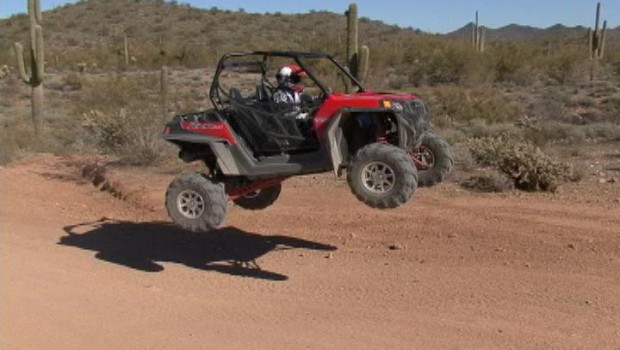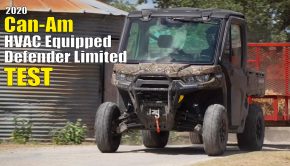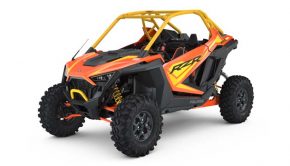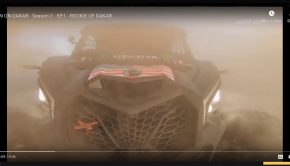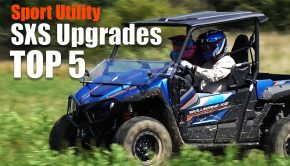2011 Polaris RZR XP 900 Review
 In 2008, Polaris introduced the first pure sport side-by-side machine with their 50 inch wide, powerful, and nimble RZR. One year later, they released the 60 inch wide RZR S. The RZR S offered an increase in stability, 12 full inches of suspension travel, and a slight boost in engine performance raising the bar in side-by-side performance even further. The following year, 2010, Polaris released the RZR 4, a stretch limo version of the RZR S, which allowed drivers the ability to accomodate up to three friends for the ride. Determined to remain at the head of the class which they created, Polaris has been hard at work developing their next generation of performance side-by-side, the 2011 RZR XP 900. For those of you not familiar with Polaris’s XP line of ATV’s, and now side-by-sides, the XP stands for “extreme performance.” We will tell you now, when it comes to the RZR XP 900, extreme performance isn’t an exaggeration, as the XP 900 has taken performance side-by-sides to a whole new level.
In 2008, Polaris introduced the first pure sport side-by-side machine with their 50 inch wide, powerful, and nimble RZR. One year later, they released the 60 inch wide RZR S. The RZR S offered an increase in stability, 12 full inches of suspension travel, and a slight boost in engine performance raising the bar in side-by-side performance even further. The following year, 2010, Polaris released the RZR 4, a stretch limo version of the RZR S, which allowed drivers the ability to accomodate up to three friends for the ride. Determined to remain at the head of the class which they created, Polaris has been hard at work developing their next generation of performance side-by-side, the 2011 RZR XP 900. For those of you not familiar with Polaris’s XP line of ATV’s, and now side-by-sides, the XP stands for “extreme performance.” We will tell you now, when it comes to the RZR XP 900, extreme performance isn’t an exaggeration, as the XP 900 has taken performance side-by-sides to a whole new level.
Technically Speaking
To build their new, “extreme performance” machine, Polaris focused on three main things–– power, suspension, and agility. Instead of building up a RZR or RZR S, they started with a completely new design. While the body styling and interior seemed familiar to us, the rest of the machine was radically different.
 To start with, the RZR XP is powered by Polaris’s all new Pro Star Engine. This power plant features a twin cylinder 875cc four-stroke design with four valves and a single overhead cam per cylinder. The engine was designed to produce 100hp per liter, so at 875cc, the engine produces a very impressive 88hp with a redline of 8750 rpms.
To start with, the RZR XP is powered by Polaris’s all new Pro Star Engine. This power plant features a twin cylinder 875cc four-stroke design with four valves and a single overhead cam per cylinder. The engine was designed to produce 100hp per liter, so at 875cc, the engine produces a very impressive 88hp with a redline of 8750 rpms.
Air and fuel are channeled to the cylinders via dual 46mm throttle bodies located right next to the head. The air box, which is located under the rear bed, features a large paper filter element that is said to offer 90% more surface area than the filter used in the RZR and RZR S. It looks like it is large enough for a car filter and is said to be free flowing, although we imagine the aftermarket will come out with a foam or K&N style filter capable of even more efficient air flow.
The air intakes for the XP’s engine and PVT transmission were located extremely high on either side of the rear of the vehicle. The engine’s air intake snakes around to help slow the progress of any water that may enter the intake. There is even a duckbill style drain plug on the bottom of the intake allowing you to get rid of any water that may have worked its way in.
Behind the intake, there is what Polaris calls a resonator box. This box serves two purposes. First, it acts as a muffler reducing the amount of noise that escapes from the intake. Secondly, the resonator box acts as an air reservoir so when you punch the throttle, there is plenty of fresh oxygen ready to be rushed into the throttle body, aiding in throttle response.
Complementing the XP’s new intake is a performance tuned exhaust, which exits out of the front of the cylinders then wraps around to the rear of the vehicle. The exhaust features stainless steel construction for corrosion resistance, helping it to stay looking good longer.
 Harnessing the machine’s 88hp is an all-new PVT transmission low and high forward ranges, plus neutral, reverse, and park. Of course, the unit is equipped with Polaris’s two-wheel drive and all-wheel drive system, selected by a dash-mounted switch. The tranny features a high performance drive clutch featuring zero lash and large buttons. From there, power is transferred to an all-new driven clutch through a drive belt, which is said to be the strongest belt Polaris makes, including the belts used in their snowmobiles!
Harnessing the machine’s 88hp is an all-new PVT transmission low and high forward ranges, plus neutral, reverse, and park. Of course, the unit is equipped with Polaris’s two-wheel drive and all-wheel drive system, selected by a dash-mounted switch. The tranny features a high performance drive clutch featuring zero lash and large buttons. From there, power is transferred to an all-new driven clutch through a drive belt, which is said to be the strongest belt Polaris makes, including the belts used in their snowmobiles!
After the power is regulated through the PVT, it travels through the transmission’s five internal drive shafts, which are all rotating in the same direction as the rest of the engine. The only right angle in the transmission is at the point where power is transferred to the front driveline. This results in a transmission that is more compact and transfers power 65% more efficiently than the ones found in the other RZR models.
Instead of starting with the existing RZR chassis, Polaris designed an all-new frame to match the capabilities of the engine. The XP is four inches wider than the RZR S at 64 inches in width and 4.5 inches longer with a wheelbase of 81.4 inches. The new chassis does feature much of the RZR’s DNA, with the engine located behind the seat helping provide a lower center of gravity and better weight distribution.
 Since the new RZR XP was built for extreme performance, it has extreme suspension with 13.5 inches of wheel travel up front, 14 inches in the rear, and 13 inches of ground clearance. The front end features a normal looking dual A-arm design. The rear suspension, on the other hand, features a three-point design with large, sturdy looking, trailing arms mounted forward on the vehicle, and dual radius rods mounted extremely close together at the rear of the machine. The trailing arm design allowed Polaris to obtain the XP’s massive rear suspension travel while minimizing scrub and optimizing camber thus providing a balance of straight-line stability and good cornering manners. Both ends feature Fox Podium X 2.0 shocks with preload and compression adjustments. The front shocks feature progressive wound springs while the rear shocks feature a dual spring setup.
Since the new RZR XP was built for extreme performance, it has extreme suspension with 13.5 inches of wheel travel up front, 14 inches in the rear, and 13 inches of ground clearance. The front end features a normal looking dual A-arm design. The rear suspension, on the other hand, features a three-point design with large, sturdy looking, trailing arms mounted forward on the vehicle, and dual radius rods mounted extremely close together at the rear of the machine. The trailing arm design allowed Polaris to obtain the XP’s massive rear suspension travel while minimizing scrub and optimizing camber thus providing a balance of straight-line stability and good cornering manners. Both ends feature Fox Podium X 2.0 shocks with preload and compression adjustments. The front shocks feature progressive wound springs while the rear shocks feature a dual spring setup.
With all of the XP’s additional performance, Polaris didn’t skimp on brakes. The front of the machine is equipped with dual bore hydraulic pistons with single bore hydraulic disc brakes in the rear.
Other features include new white LED lights which are said to better mimic the light provided by the sun, casting less shadows in darkness. There’s a digital gauge providing odometer, tachometer, trip meter, hour meter, clock, gear indicator, fuel gauge, hi-temp/low battery lights, and coolant temp indicator, plus an easy to read analog speedometer. The cargo bed features Polaris’s lock and ride system for attaching various bed accessories and Pure Polaris is already prepared for the new model with skid plates, bumpers, roofs, plus many other accessories.
The Test
 After taking a short loop in the other Polaris RZR vehicles to re-familiarize ourselves with their performance, we strapped ourselves into the XP and headed out into the Arizona desert. On the 15mph road leaving our base camp, the XP was kind of deceiving as its exhaust note isn’t particularly loud or rumbling from the cockpit. As soon as the speed restrictions were lifted, though, we stabbed the gas pedal, immediately realizing that the Pro Star 900 produces a serious amount of instantly available power.
After taking a short loop in the other Polaris RZR vehicles to re-familiarize ourselves with their performance, we strapped ourselves into the XP and headed out into the Arizona desert. On the 15mph road leaving our base camp, the XP was kind of deceiving as its exhaust note isn’t particularly loud or rumbling from the cockpit. As soon as the speed restrictions were lifted, though, we stabbed the gas pedal, immediately realizing that the Pro Star 900 produces a serious amount of instantly available power.
The thrust provided by the Pro Star 900 engine is unlike anything we have experienced in a stock side-by-side. We would compare the power to the fully built Muzzy’s 840cc kitted Funco Teryx we tested a while back; however, the Polaris XP runs much cooler and is bone stock! The XP produces good low-end power, although it could be easily overlooked due to the engine’s massive midrange and screaming top-end! Power is available at any point in the RPM range and throttle response is instant even at 60mph in a rock-covered silt bed. The XP is said to top out at 75mph, but we never found a place flat and straight enough to push it to the limit.
Handling on the RZR XP was super stable and sure-footed. Test rider Rob Frede drove it like a mad man all day, never coming close to finding the limits of the vehicle’s stability in corners, thanks to its extra width and minimal body roll. The XP is pretty predictable through turns, although the super responsive engine and longer wheelbase made the rear end break loose faster than the other RZR models. Flip it into all-wheel drive and you could exit corners more predictably with little concern for throttle control. Fortunately, making the switch to all-wheel drive had little effect on the machine’s steering.
 Did you ever think you could wheelie a side-by-side? Well, with so much power and superb weight balance, we could actually carry the front end over some whoop sections. The power and balance also played a huge role in making this the best jumping side-by-side we have ever driven, stock or modified. Roll on the gas launching off jumps, and the XP flies straight and true. We actually landed on the rear wheels first almost every time we went big, further boosting our confidence and control.
Did you ever think you could wheelie a side-by-side? Well, with so much power and superb weight balance, we could actually carry the front end over some whoop sections. The power and balance also played a huge role in making this the best jumping side-by-side we have ever driven, stock or modified. Roll on the gas launching off jumps, and the XP flies straight and true. We actually landed on the rear wheels first almost every time we went big, further boosting our confidence and control.
Although it sounds cliché, when it comes to eating up big jumps or two and a half foot deep whoops, the XP’s suspension actually worked better the faster we drove it––and that’s no BS! We never bottomed either end hard off jumps and we laughed like schoolgirls as we floated across whoops that would have caused us to crash our brains out on any other stock side-by-side. With so much travel, Polaris was able to soften up the first few inches of movement providing a plusher ride over stutter bumps compared to their other RZR models.
Braking power on the 900 is definitely on par with its exceptional engine. The brakes not only provide a massive amount of binding force, they mimic the feeling of automotive brakes, allowing you to easily modulate the amount of braking force used.
 Ergonomically, the RZR XP feels very similar to the other RZR models, with comfortable seats, and recessed heel pocket below the gas pedal making throttle modulation easy. There’s also the much appreciated “oh shit bar” for the passenger to hold on to, a feature no side-by-side should be without.
Ergonomically, the RZR XP feels very similar to the other RZR models, with comfortable seats, and recessed heel pocket below the gas pedal making throttle modulation easy. There’s also the much appreciated “oh shit bar” for the passenger to hold on to, a feature no side-by-side should be without.
Feeling we need to complain about something, the machine’s steering, which is 20% more responsive than the other RZR models, also provides a bit more unwanted feedback to the steering wheel from trail obstacles. What’s good is that current XP models are already wired for EPS that will soon be offered as an accessory add-on for existing models. Perhaps Polaris could have equipped the vehicle with five point restraints to match the rest of the machine’s extreme performance. Finally, we hope that the aftermarket can come up with a tire that won’t be shredded by the 900’s engine. After just two days of use, the tough ITP 900 rear tires were showing significant wear.
Our Conclusion.
While its base price of $15,999 may seem a bit staggering, go ahead and buy any other side-by-side on the market, and add five or six thousand dollars worth of aftermarket performance parts. Chances are you won’t wind up with a machine as capable or reliable as the bone stock Polaris RZR XP 900. Polaris has set a new standard for their competitors to aim for and they better aim high. We were blown away by the performance of the 2011 Polaris RZR XP 900 and are absolutely sure you will be too!
For more information on the all new Polaris RZR XP 900, or their full line of side by sides and ATVs, log onto www.polarisindustirs.com
| Engine | |
| Engine Type | 4-Stroke DOHC Twin Cylinder |
| Displacement | 875cc |
| Fuel System | Electronic Fuel Injection |
| Cooling | Liquid |
| Drivetrain | |
| Transmission/Final Drive | Automatic PVT P/R/N/L/H; Shaft |
| Drive System | On-Demand True AWD/2WD |
| Suspension | |
| Front Suspension | Dual A-Arm Fox Podium X 2.0 (comp adjust/res.) 13.5″ (34.3 cm) Travel |
| Rear Suspension | Trailing Arm Fox Podium X 2.0 (comp adjust/res.) 14″ (35.6 cm) Travel |
| Brakes | |
| Front/Rear Brakes | 4-Wheel Hydraulic Disc with Dual-Bore Front Calipers |
| Parking Brake | Park in Transmission |
| Tires Wheels | |
| Front Tires / Model | 27 x 9-12; ITP 900 XCT |
| Rear Tires / Model | 27 x 11-12; ITP 900 XCT |
| Wheels | Cast Aluminum |
| Dimensions | |
| Wheelbase | 81.4″ (206.8 cm) |
| Dry Weight | 1,190 lbs. (539.8 kg) |
| Overall Vehicle Size (LxWxH) | 108.4″ x 64″ x 73″ (275.3 x 162.6 x 185.4 cm) |
| Ground Clearance | 13″ (33.0 cm) |
| Capacities | |
| Fuel Capacity | 7.25 gal (27.4 L) |
| Bed Box (LxWxH) | 23 x 38 x 10″ (58.4 x 96.5 x 25.4 cm) |
| Box Capacity | N.A./300 lb (136.1 kg) |
| Payload Capacity | 740 lb (335.6 kg) |
| Hitch Towing Rating | N.A. |
| Hitch/Type | None |
| Features | |
| Cargo System | Lock & Ride |
| Lighting | White LED, High/Low |
| Power Steering | Not Equipped |
| Instrumentation | Digital Gauge, Speedometer, Odometer, Tachometer, Tripmeter, Hour Meter, Clock, Gear Indicator, Fuel Gauge, Hi-Temp/Low-Batt Lights, Coolant Temp, DC Outlet |
2011 Polaris RZR XP 900 Ratings
Summary: While its base price of $15,999 may seem a bit staggering, go ahead and buy any other side-by-side on the market, and add five or six thousand dollars worth of aftermarket performance parts. Chances are you won’t wind up with a machine as capable or reliable as the bone stock Polaris RZR XP 900. Polaris has set a new standard for their competitors to aim for and they better aim high. We were blown away by the performance of the 2011 Polaris RZR XP 900 and are absolutely sure you will be too!

